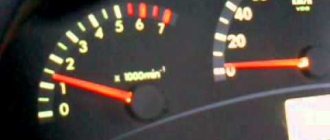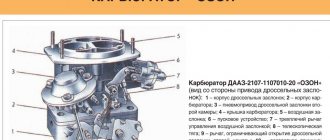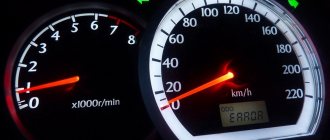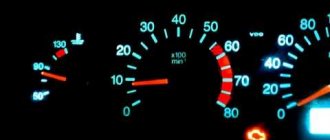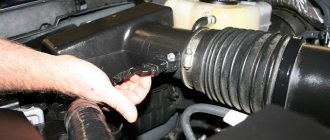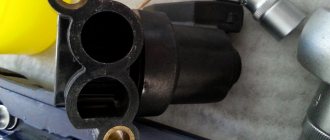It is very important that the engine operates correctly in any mode, including idling. However, many car owners are faced with a problem: when they release the gas, the engine speed does not drop. As soon as such a defect is discovered, it is necessary to immediately find out the cause and eliminate the malfunction for the smooth operation of the car. Also, the engine may slow down for a long time, which also does not contribute to proper operation.
Typically, upon reaching operating temperature, the speed should drop to its normal level. The manufacturer indicates the indicators for each specific vehicle model in the operating manual. They may vary slightly depending on the mileage and general condition of the car, but usually stay within the range of 650-1000 rpm.
In some cases, the speed drops very slowly or even stays at the same level of 1500-2000 revolutions. In this mode, not only does fuel consumption increase, which affects the driver’s finances, but it also contributes to engine wear.
The cause of the idle failure must be diagnosed by qualified technicians. However, you can also understand on your own why the engine speed does not drop.
Problems with the carburetor system
When releasing gas, the drop in speed can be bad for both injectors and carburetor systems.
If the car has a carburetor, then there may be several defects.
Most often, the speed does not drop due to a faulty throttle valve. When the engine warms up, it is in the open position to allow more air into the system. Then it closes and the speed should drop.
If the throttle valve is not closed completely, the mixture will still be over-rich when the operating temperature is reached, and the speed will remain at the same level. If this part is heavily soiled or deformed, it cannot close completely.
You can clean the damper using a special product, which can be purchased at an automotive supply store. Deformation may require replacing the carburetor completely. The damper may not close tightly if the drive cable is severely worn. Replacing it may improve the situation.
Another common reason why the engine speed does not drop when idling is the gasket between the carburetor and the cylinder head, which has become unusable, or a damaged intake manifold.
After replacing the carburetor or cleaning the power system, you can often notice that the engine speed is slowly dropping. This occurs due to improper adjustment of the idle system; an over-enriched air-fuel mixture is often supplied. To eliminate the malfunction, it is necessary to adjust the ratio of fuel and air supply to the system.
A high level of fuel in the carburetor float chamber can also cause a malfunction. The needle valve is responsible for it. Checking this detail may correct the situation.
Conclusion
If your car has floating idle speed, you must:
- Remember if you have recently refueled at low-quality gas stations.
- Check the system for air leaks.
- Check all sensors that are involved in the formation of the fuel mixture.
- Check the fuel pressure in the system.
All these tips will help you independently find the cause of a breakdown in your car and fix it without much expense.
We hope our article was useful to you.
Injector system
If your car has an injection system, there may be many more reasons for high idle speeds. Here, both mechanical elements and electronic devices responsible for adjusting the idle speed can fail.
The main injector malfunctions include:
- Incorrect operation of the temperature sensor installed in the cooling system. Incorrectly received data from this device causes the electronics to recognize the engine as cold and work to warm it up, thereby maintaining high speeds necessary to reach operating temperature. Overheating can often occur, which leads to more serious damage, including major engine repairs. The same effect is possible if the idle speed control is not operating correctly.
- The throttle control cable may become stuck. The higher the mileage of the car, the higher the risk of encountering a similar problem.
- The electronic XX operation sensor often malfunctions, then the speed will either increase or disappear altogether.
- The spring that brings the throttle valve to its original closed position is not functioning properly, is jumping off, or is being stretched too far.
- Too much air enters the fuel combustion chamber due to poor quality or leaky gaskets. It is necessary to carefully check the seals of the manifold and injectors.
- And the simplest reason is usually the incorrect placement of the mat after a visit to a car wash or dry cleaning of the interior. It is often inaccurately placed under the accelerator pedal, which leads to the appearance of improper engine operation.
Your own diagnostician: why the engine speed fluctuates on a Priora - a theoretical basis
- failure of the mass air flow sensor (MAF);
- failure of the throttle position sensor (TPS);
- air leak;
- defective idle air controller (IAC).
What the engine will do in this state of affairs is to raise the speed of the power plant, while the volume of injected gasoline will remain the same. This means that the mixture will become leaner and the engine will begin to stall smoothly.
As the crankshaft speed decreases, the amount of air will decrease. After reaching a critical point, at which the injection volume of high-octane liquid is sufficient to obtain a combustible mixture of normal quality, engine operation stabilizes again. This process is called “floating revolutions”. It is closed and will be repeated until the causes are clarified and measures are taken to eliminate them.
Floating speed
In addition to slowly falling revs, car enthusiasts may encounter a phenomenon called floating revs, when they drop and then rise sharply. The reason is excessive air supply into the system, which causes the engine to spin up to 2 thousand revolutions at idle.
This often happens in cars that have a fuel injection sensor. It calculates how much air the mixture needs. When its operation is disrupted, different amounts of oxygen are supplied at different times, as a result, speed jumps are observed approximately every 3 seconds.
Faced with a similar phenomenon, the same computer diagnostics will be a prerequisite. It is very important that this and all subsequent work is carried out by experienced, qualified specialists. By contacting a service that does not specialize in breakdowns of this kind, you may be faced with the need to carry out an expensive overhaul of the engine ahead of time.
For normal engine operation and acceptable fuel consumption, it is necessary that all power unit systems operate properly. In this case, the engine should operate normally both under load and in idle mode.
In this article we will talk about why engine speed does not drop, and also consider the main reasons why such problems arise on carburetor and injection cars.
Read in this article
Lada Priora idle speed fluctuates: reasons, repairs
In the case of the Priora, we have a 16-valve engine with an injector, which means with electronic fuel supply. You can often encounter a situation where the engine speed begins to “dance”, and sometimes the car even accelerates on its own, when there is not even any pressure on the gas pedal. Most often this happens when the engine is hot.
But this also happens at low temperatures, when in the morning, after starting the car, you can observe inadequate engine operation. In individual cases, interruptions may disappear on their own as the car warms up.
To begin with, it is recommended to diagnose the product to identify the root cause of the malfunction. The following points are worth considering:
- Is the engine filter clogged?
- Check the serviceability of the spark plugs.
- Condition of high voltage wiring.
- Make sure that the idle speed control and its electrics are in good working order.
- The oxygen supply sensor is faulty.
- Avoid damage to the temperature sensor.
- Is the on-board computer normal?
Floating speed: reasons
Note that in some cases the revolutions do not just slowly fall or remain at the same level, but “float”. In this case, the engine may become unstable. Floating speeds first fall, then increase sharply and everything repeats. A common cause of this phenomenon is the supply of excess air, which leads to “jumps” in speed at idle.
If malfunctions occur, the control unit cannot prepare the “correct” mixture for the idle mode, which causes speed jumps after releasing the gas pedal or when the engine is idling.
Mechanical problems
First, you should check the throttle cable. Quite often it jams, and the pedal “sticks” when the driver has already removed his foot and the speed has not decreased. This may be due to the following problems:
- Corrosion of the cable
. At the same time, it simply gets stuck in the shirt; - Lubrication
. Sometimes drivers, in an effort to improve the operation of the unit, lubricate the cable; in winter, the lubricant freezes, which causes jamming; - Unsuccessful repair
. In some cases, after repairs, car owners incorrectly position the cable, resulting in problems.
Let's sum it up
As you can see, in order to accurately determine why the engine speed is not reset, in many cases in-depth diagnostics may be necessary. For carburetor engines, cleaning and adjustment of the carburetor itself is often necessary, while the injector will require computer diagnostics.
If the problem is not on the surface (the throttle cable has become sour, after washing or dry cleaning, the carpet in the cabin is not installed correctly, which presses the gas pedal, etc.), then it is better to take the car to a service center.
The most complex situation is when the design of the power system involves the presence of a large number of sensors and actuators. In this case, even the use of diagnostic equipment does not always allow you to quickly and accurately determine the problem.
Route map for eliminating unstable XX on a VAZ 2170
Unstable idle is caused by the fact that the computer incorrectly perceives or does not know at all the amount of air sucked into the intake manifold. A typical treatment recipe looks like this:
- Check the sensors (IAC, DFID, TPS) and replace the faulty ones.
- Make sure that the adsorber valve is in good condition.
- If, after cleaning the throttle valve on the VAZ 21126 engine, the speed fluctuates, you need to make sure that there is no air leakage through the connections to the pipes.
- Check whether the diaphragm in the vacuum brake booster is intact.
Experienced advice needed! Priora 2009 It began to spontaneously gain momentum... I’m standing at a traffic light and then once you hit 3000 and it doesn’t let up, I press the gas as much as I pressed and hold it, then it goes away on its own and so on 20 times a day!! I cleaned the throttle, changed the throttle position sensor, changed the idle sensor and nothing helps! Now, only when you roll in neutral, it still boosts up to 1200. What is the problem, has anyone encountered it?
I'm renovating and moving
by Adminrive Published 10/09/2016
As far as I understand, the firmware is stock
by Adminrive · Published 03/16/2017
Priora does not slow down
It is very important that the engine operates correctly in any mode, including idling. However, many car owners are faced with a problem: when they release the gas, the engine speed does not drop. As soon as such a defect is discovered, it is necessary to immediately find out the cause and eliminate the malfunction for the smooth operation of the car. Also, the engine may slow down for a long time, which also does not contribute to proper operation.
Typically, upon reaching operating temperature, the speed should drop to its normal level. The manufacturer indicates the indicators for each specific vehicle model in the operating manual. They may vary slightly depending on the mileage and general condition of the car, but usually stay within the range of 650-1000 rpm.
In some cases, the speed drops very slowly or even stays at the same level of 1500-2000 revolutions. In this mode, not only does fuel consumption increase, which affects the driver’s finances, but it also contributes to engine wear.
The cause of the idle failure must be diagnosed by qualified technicians. However, you can also understand on your own why the engine speed does not drop.
Replacement
Replacement requires only a small screwdriver.
- We turn off the minus sign in the battery, since the work will be done with the electrical equipment of the car.
- Remove the connector from the sensor.
Unscrew the two screws that secure the sensor to the housing and remove the sensor.
- We install the new sensor in the reverse order, not forgetting to install the O-ring.
If after replacement the problem is not solved, you need to clean the throttle valve; how to do this, read below.
The engine chokes when you press the gas pedal
Yes, I'm stuck, full throttle at idle. but everyone understood))) There are such moronic sellers, then you buy yourself a gift like this and you will suffer, although you will not even think about what they did with this car. forester.sg5 xt 03′ legacy b4.bl5 gt 08′ hr-v gh4 00′ forester.sh5 xt 08′
At idle speed (i.e. in neutral), pressing the gas pedal to the floor is impossible? IMHO, you're being picky
